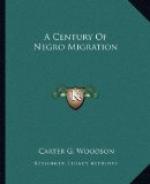[Footnote 7: Turner, The Negro in Pennsylvania, pp. 144, 145, 151, 155.]
[Footnote 8: Southern Workman, xxxvii, p. 157.]
[Footnote 9: Levi Coffin, Reminiscences, chaps, i and ii.]
[Footnote 10: Southern Workman, xxxvii, pp. 161-163.]
[Footnote 11: Coffin, Reminiscences, p. 109; and Howe’s Historical Collections, p. 356.]
[Footnote 12: Southern Workman, xxxvii, pp. 162, 163.]
[Footnote 13: Levi Coffin, Reminiscences, pp. 108-111.]
[Footnote 14: Siebert, The Underground Railroad, p. 249.]
[Footnote 15: Langston, From the Virginia Plantation to the National Capitol, p. 35.]
[Footnote 16: Howe, Historical Collections, p. 465.]
[Footnote 17: History of Brown County, Ohio, p. 313.]
[Footnote 18: Wattles said: he purchased for himself 190 acres of land, to establish a manual labor school for colored boys. He had maintained a school on it, at his own expense, till the eleventh of November, 1842. While in Philadelphia the winter before, he became acquainted with the trustees of the late Samuel Emlen, a Friend of New Jersey. He left by his will $20,000 for the “support and education in school learning and the mechanic arts and agriculture, boys, of African and Indian descent, whose parents would give them up to the school. They united their means and purchased Wattles farm, and appointed him the superintendent of the establishment, which they called the Emlen Institute.”—See Howe’s Historical Collections, p. 356.]
[Footnote 19: Howe’s Historical Collections, p. 355.]
[Footnote 20: Manuscripts in the possession of J.E. Moorland.]
[Footnote 21: The African Repository, xxii, pp. 322, 333.]
[Footnote 22: Simmons, Men of Mark, p. 723.]
[Footnote 23: Southern Workman, xxxvii, p. 158.]
[Footnote 24: The Journal of Negro History, I, pp. 23-33.]
[Footnote 25: Ibid., I, p. 26.]
[Footnote 26: The African Repository, passim.]
[Footnote 27: Although constituting a majority of the population even before the Civil War the Negroes of this township did not get recognition in the local government until 1875 when John Allen, a Negro, was elected township treasurer. From that time until about 1890 the Negroes always shared the honors of office with their white citizens and since that time they have usually had entire control of the local government in that township, holding such offices as supervisor, clerk, treasurer, road commissioner, and school director. Their record has been that of efficiency. Boss rule among them is not known. The best man for an office is generally sought; for this is a community of independent farmers. In 1907 one hundred and eleven different farmers in this community had holdings of 10,439 acres. Their township usually has very few delinquent taxpayers and it promptly makes its returns to the county.—See the Southern Workman, xxxvii, pp. 486-489.]




